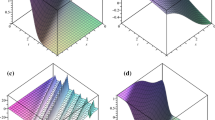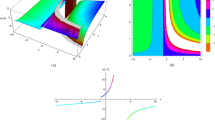Abstract
We present an algorithm for the numerical solution of nonlinear parabolic partial differential equations. This algorithm extends the classical Feynman–Kac formula to fully nonlinear partial differential equations, by using random trees that carry information on nonlinearities on their branches. It applies to functional, non-polynomial nonlinearities that are not treated by standard branching arguments, and deals with derivative terms of arbitrary orders. A Monte Carlo numerical implementation is provided.









Similar content being viewed by others
Data availability statement
No new data were created during the study.
References
C. Beck, S. Becker, P. Cheridito, A. Jentzen, and A. Neufeld. Deep splitting method for parabolic PDEs. Preprint ar**v:1907.03452, 2019.
S. Becker, R. Braunwarth, M. Hutzenthaler, A. Jentzen, and Ph. von Wurstemberger. Numerical simulations for full history recursive multilevel Picard approximations for systems of high-dimensional partial differential equations. Preprint ar**v:2005.10206v2, 2020.
S. Bonaccorsi, M. D’Ovidio, and S. Mazzucchi. Probabilistic representation formula for the solution of fractional high-order heat-type equations. J. Evol. Equ., 19:523–558, 2019.
C. Beck, W. E, and A. Jentzen. Machine learning approximation algorithms for high-dimensional fully nonlinear partial differential equations and second-order backward stochastic differential equations. J. Nonlinear Sci., 29(4):1563–1619, 2019.
Y. Bruned, M. Hairer, and L. Zambotti. Algebraic renormalisation of regularity structures. Invent. Math., 215:1039–1156, 2019.
J.C. Butcher. Coefficients for the study of Runge-Kutta integration processes. J. Austral. Math. Soc., 3:185–201, 1963.
J.C. Butcher. Trees and numerical methods for ordinary differential equations. Numerical Algorithms, 53:153–170, 2010.
A. Connes and D. Kreimer. Lessons from quantum field theory: Hopf algebras and spacetime geometries. Letters in Mathematical Physics, 48:85–96, 1999.
S. Chakraborty and J.A. López-Mimbela. Nonexplosion of a class of semilinear equations via branching particle representations. Advances in Appl. Probability, 40:250–272, 2008.
G.M. Constantine and T.H. Savits. A multivariate Faa di Bruno formula with applications. Trans. Amer. Math. Soc., 348(2):503–520, 1996.
P. Cheridito, H.M. Soner, N. Touzi, and N. Victoir. Second-order backward stochastic differential equations and fully nonlinear parabolic PDEs. Comm. Pure Appl. Math., 60(7):1081–1110, 2007.
P. Deuflhard and F. Bornemann. Scientific Computing with Ordinary Differential Equations, volume 42 of Texts in Applied Mathematics. Springer-Verlag, New York, 2002.
W. E, M. Hutzenthaler, A. Jentzen, and T. Kruse. On multilevel Picard numerical approximations for high-dimensional nonlinear parabolic partial differential equations and high-dimensional nonlinear backward stochastic differential equations. Journal of Scientific Computing, 79:1534–1571, 2019.
W. E, M. Hutzenthaler, A. Jentzen, and T. Kruse. Multilevel Picard iterations for solving smooth semilinear parabolic heat equations. Partial Differential Equations and Applications, 2, 2021.
L. Fossy. Algebraic structures on typed decorated rooted trees. SIGMA, 17:1–28, 2021.
A. Fahim, N. Touzi, and X. Warin. A probabilistic numerical method for fully nonlinear parabolic PDEs. Ann. Appl. Probab., 21(4):1322–1364, 2011.
M. Gubinelli. Ramification of rough paths. J. Differential Equations, 248(4):693–721, 2010.
W. Guo, J. Zhang, and J. Zhuo. A monotone scheme for high-dimensional fully nonlinear PDEs. Ann. Appl. Probab., 25(3):1540–1580, 2015.
J. Han, A. Jentzen, and W. E. Deep learning-based numerical methods for high-dimensional parabolic partial differential equations and backward stochastic differential equations. Preprint ar**v:1706.04702, 39 pages, 2017.
J. Han, A. Jentzen, and W. E. Solving high-dimensional partial differential equations using deep learning. Proceedings of the National Academy of Sciences, 115(34):8505–8510, 2018.
M. Hutzenthaler, A. Jentzen, and T. Kruse. Overcoming the curse of dimensionality in the numerical approximation of parabolic partial differential equations with gradient-dependent nonlinearities. Found. Comput. Math., 22:905–966, 2022.
M. Hutzenthaler, A. Jentzen, T. Kruse, and T.A. Nguyen. Multilevel Picard approximations for high-dimensional semilinear second-order PDEs with Lipschitz nonlinearities. Preprint ar**v:2009.02484v4, 2020.
P. Henry-Labordère. Counterparty risk valuation: a marked branching diffusion approach. Preprint ar**v:1203.2369, 2012.
P. Henry-Labordère, N. Oudjane, X. Tan, N. Touzi, and X. Warin. Branching diffusion representation of semilinear PDEs and Monte Carlo approximation. Ann. Inst. H. Poincaré Probab. Statist., 55(1):184–210, 2019.
P. Henry-Labordère and N. Touzi. Branching diffusion representation for nonlinear Cauchy problems and Monte Carlo approximation. Ann. Appl. Probab., 31(5):2350–2375, 2021.
P. Henry-Labordère, X. Tan, and N. Touzi. A numerical algorithm for a class of BSDEs via the branching process. Stochastic Processes and their Applications, 124(2):1112–1140, 2014.
E. Hairer, C. Lubich, and G. Wanner. Geometric numerical integration, volume 31 of Springer Series in Computational Mathematics. Springer-Verlag, Berlin, second edition, 2006.
S. Huang, G. Liang, and T. Zariphopoulou. An approximation scheme for semilinear parabolic PDEs with convex and coercive Hamiltonians. SIAM J. Control Optim., 58(1):165–191, 2020.
C. Huré, H. Pham, and X. Warin. Deep backward schemes for high-dimensional nonlinear PDEs. Mathematics of Computation, 2020.
N. Ikeda, M. Nagasawa, and S. Watanabe. Branching Markov processes I, II, III. J. Math. Kyoto Univ., 8-9:233–278, 365–410, 95–160, 1968-1969.
N.V. Krylov. Boundedly nonhomogeneous elliptic and parabolic equations. Math. USSR, Izv., 20:459–492, 1983.
T. Kong, W. Zhao, and T. Zhou. Probabilistic high order numerical schemes for fully nonlinear parabolic PDEs. Commun. Comput. Phys., 18(5):1482–1503, 2015.
W. Lefebvre, G. Loeper, and H. Pham. Differential learning methods for solving fully nonlinear PDEs. Preprint ar**v:2205.09815, 2022.
H.P. McKean. Application of Brownian motion to the equation of Kolmogorov-Petrovskii-Piskunov. Comm. Pure Appl. Math., 28(3):323–331, 1975.
R.I. McLachlan, K. Modin, H. Munthe-Kaas, and O. Verdier. Butcher series: a story of rooted trees and numerical methods for evolution equations. Asia Pac. Math. Newsl., 7(1):1–11, 2017.
A. Neufeld and S. Wu. Multilevel Picard approximation algorithm for semilinear partial integro-differential equations and its complexity analysis. Preprint ar**v:2205.09639, 2022.
S. Peng. Probabilistic interpretation for systems of quasilinear parabolic partial differential equations. Stochastics Stochastics Rep., 37(1-2):61–74, 1991.
É. Pardoux and S. Peng. Backward stochastic differential equations and quasilinear parabolic partial differential equations. In Stochastic partial differential equations and their applications (Charlotte, NC, 1991), volume 176 of Lecture Notes in Control and Inform. Sci., pages 200–217. Springer, Berlin, 1992.
G. Penent and N. Privault. Existence and probabilistic representation of the solutions of semilinear parabolic PDEs with fractional Laplacians. Stochastics and Partial Differential Equations: Analysis and Computations, 10:446–474, 2022.
G. Penent and N. Privault. Numerical evaluation of ODE solutions by Monte Carlo enumeration of Butcher series. BIT Numerical Mathematics, 62:1921–1944, 2022.
H. Pham, X. Warin, and M. Germain. Neural networks-based backward scheme for fully nonlinear PDEs. Partial Differ. Equ. Appl., 2(1):Paper No. 16, 24, 2021.
A.V. Skorokhod. Branching diffusion processes. Teor. Verojatnost. i. Primenen., 9:492–497, 1964.
J. Sirignano and K. Spiliopoulos. DGM: A deep learning algorithm for solving partial differential equations. Journal of Computational Physics, 375:1339–1364, 2018.
H.M. Soner, N. Touzi, and J. Zhang. Wellposedness of second order backward SDEs. Probab. Theory Related Fields, 153(1-2):149–190, 2012.
X. Tan. A splitting method for fully nonlinear degenerate parabolic PDEs. Electron. J. Probab., 18:no. 15, 24, 2013.
Acknowledgements
We thank an anonymous referee for insightful comments that helped us improve this paper. This research is supported by the Ministry of Education, Singapore, under its Tier 2 Grant MOE-T2EP20120-0005.
Author information
Authors and Affiliations
Corresponding author
Ethics declarations
Conflict of interest
The authors have no competing interests to declare that are relevant to the content of this article.
Additional information
Publisher's Note
Springer Nature remains neutral with regard to jurisdictional claims in published maps and institutional affiliations.
A Computer codes
A Computer codes
The following codes implement the algorithm of Theorem 1 in Mathematica using an exponential distribution \(\rho (t) = \textrm{e}^{-t}\), \(t\ge 0\). In the above examples the values of fdb[n,k] have been precomputed by memoization for k up to 7 in order to speed up the solution algorithm, where n denotes the highest order of derivative \(\partial _x^n\) in (1.1). The next code implements the mechanism \(c \mapsto {\mathcal {M}}(c)\) in the procedure “codetofunction” via the combinatorics of the Faà di Bruno formula written the function “fdb”.

Numerical solution estimates are then computed using the following program, in which the code \(\partial _x^k\) is represented by \(\{-k\}\), \(k\ge 1\), and the code \(\big ( \partial _{z_0}^{\lambda _0} \cdots \partial _{z_n}^{\lambda _n} f\big )^* \) is represented by \(\{ \lambda _0, \ldots , \lambda _n \} \in {\mathord {{\mathbb {R}}}}^{n+1}\).

Rights and permissions
Springer Nature or its licensor (e.g. a society or other partner) holds exclusive rights to this article under a publishing agreement with the author(s) or other rightsholder(s); author self-archiving of the accepted manuscript version of this article is solely governed by the terms of such publishing agreement and applicable law.
About this article
Cite this article
Nguwi, J.Y., Penent, G. & Privault, N. A fully nonlinear Feynman–Kac formula with derivatives of arbitrary orders. J. Evol. Equ. 23, 22 (2023). https://doi.org/10.1007/s00028-023-00873-3
Accepted:
Published:
DOI: https://doi.org/10.1007/s00028-023-00873-3
Keywords
- Fully nonlinear PDEs
- Quasilinear PDEs
- Semilinear PDEs
- Parabolic PDEs
- Gradient nonlinearities
- Branching processes
- Monte-Carlo method




